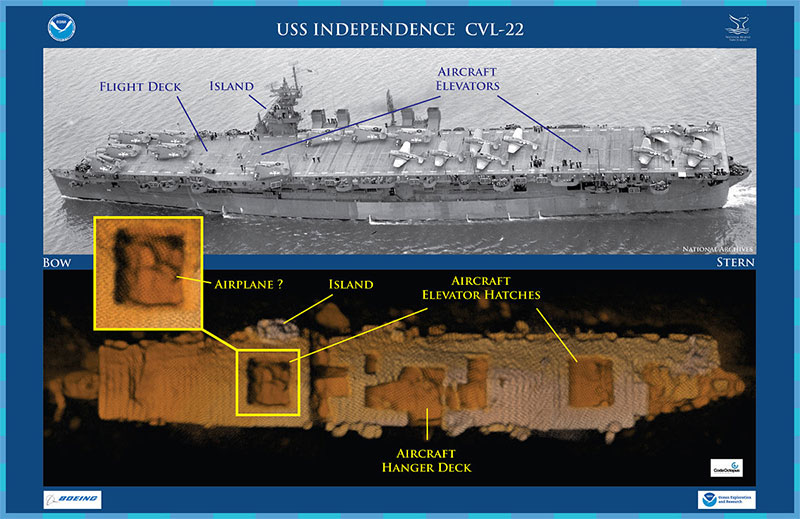NOAA, Boeing Surveyed World War II Aircraft Carrier Wreck Site
May 11, 2015

Features on an historic photo of USS Independence CVL 22 are captured in a three-dimensional low-resolution sonar image of the shipwreck. The Coda Octopus Echoscope 3D sonar, integrated on the Boeing autonomous underwater vehicle (AUV) Echo Ranger, imaged the shipwreck during the first maritime archaeological survey. The sonar image with oranges color tones (lower) shows an outline of a possible airplane in the forward aircraft elevator hatch opening. Image courtesy of NOAA, Boeing, and Coda Octopus.
From March 2 to 20, NOAA’s Office of National Marine Sanctuaries (OMNS), the NOAA Office of Ocean Exploration and Research (OER), and Boeing conducted an expedition to survey the wreck of the World War II aircraft carrier USS Independence as part of a mission to locate and document historic shipwrecks in Gulf of the Farallones National Marine Sanctuary and nearby waters.
Independence is famous for its role in the war and its postwar involvement in nuclear testing at Bikini Atoll. The ship was intentionally sunk in 1951, 20 miles at sea, in 3,000 feet of water off California’s Farallone Islands. Tests of Independence at that time indicated the ship had little if any remaining radiation from its involvement at Bikini Atoll.Using bathymetric data and maps acquired by OER in 2009, the team used Boeing’s large state-of-the-art autonomous underwater vehicle (AUV) equipped with an advanced Coda Octopus three-dimensional mapping sonar to “fly” over the wreck to map it in detail. ONMS is legally required to map and understand cultural and heritage sites in each sanctuary, and uses such survey data to educate the public.
Press release: NOAA, partners, survey 'amazingly intact' historic WWII-era aircraft carrier